SEO
9 SaaS Marketing Strategies for Sustainable Growth

Sustainable growth for a SaaS company is about creating long-term value that is a) profitable and b) able to be maintained over time without compromising the brand’s reputation. In other words, by building growth, you’re building a foundation for more growth as you go.
We’ll talk about nine marketing strategies that are perfect for achieving and maintaining sustainable growth.
Product-market fit (PMF) is when a business has confirmed signals that its product can satisfy an existing demand in a market with high potential.
The usual sign of achieving PMF is when people are willing to buy the product (even if it’s not perfect yet), actively use it, and recommend it to others.
This is a sustainable strategy because it allows you to make sure you’re building something meaningful that will actually get paying users.
PMF automatically makes your messaging more effective. You’re promoting a product people want. And you already know who you’re talking to, so your marketing dollars are better spent.
Conversely, if none of your marketing efforts seem to work, the problem may be the product and not how creative or well funded your campaigns are.
You can find SaaS companies with product-market fit all around. These will be companies that still offer the same kind of products that made them profitable: Slack, Atlassian, Shopify, etc.
How it works
The general idea is to ship a Minimum Viable Product (MVP) and iterate on it based on real user input until you see that people actively use it and recommend it.
There are five steps in the process:
- Formulate the value hypothesis: Why is a customer likely to buy your product?
- Specify the features of your MVP: The right quantity and quality of features needed to verify the value hypothesis.
- Build your MVP: There are many ways to present your product to your audience; you don’t necessarily need to develop a fully functional product.
- Test the MVP with real users: In other words, get feedback.
- Learn from your users and iterate: Some ideas will need more work, while some are probably destined to fail. Gather your data and make the decision.
When you achieve PMF, it will be time to scale your company and marketing efforts.
This strategy doesn’t need an introduction. We’ve all used product trials and free tools. That said, this strategy can be looked at from different angles. What’s important from a marketing perspective are these three benefits:
- Reduced friction – This means there are fewer objections to trying your product.
- Time to experience the value of the product and get hooked – Reading about a product on a landing page is not the same as experiencing it. Your potential customers will likely expect the possibility to put their hands on the product before they buy.
- Direct marketing channel – You can ask users to sign up for a newsletter or send them messages concerning the product.
For instance, HubSpot carves out parts of the platform for free usage (e.g., CRM, CMS). It does this, as it explains, to increase the force of its marketing flywheel. Or in other words, to propel its entire business model.
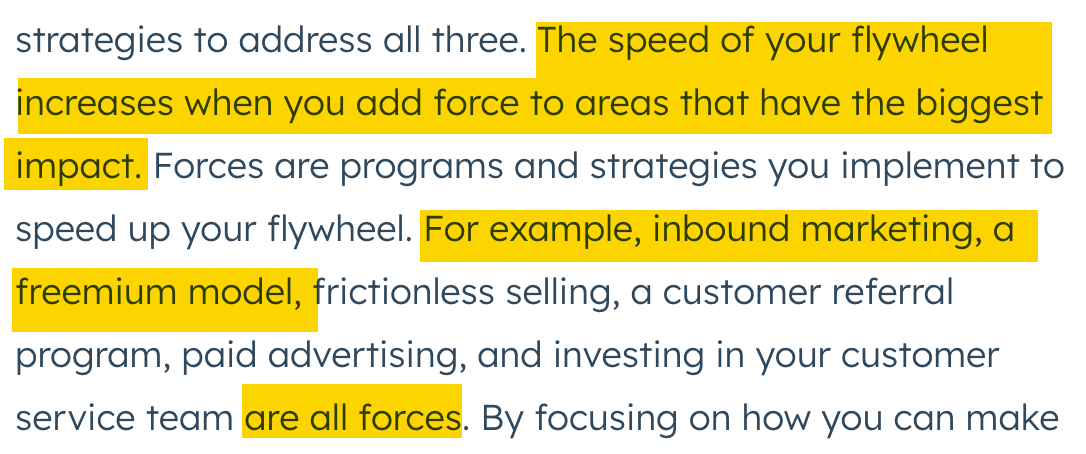
How it works
Start by weighing the pros and cons of free and freemium products.
| Pros | Cons |
|---|---|
| Less friction with getting people to use your product. | Harder to manage expectations. People may expect to get more things for free. |
| Bigger user base. | More server load and possibly more queries to support. |
| Works well with growth loops (more on that later). | Offering something for free may reduce its perceived value. |
| Direct marketing channel to signed-up users (content distribution and upselling). | |
| More feedback. |
Getting users in front of free products is only part of the job. The harder part is getting them to upgrade.
First off, you need to set the right expectations—you won’t convert all of them. For the ones that are “convertible,” here are some tactics you can use:
- Never stop improving customer satisfaction. What your product does and how it does it is absolutely fundamental.
- Educate users about the product. Use blog posts, videos, or quick in-app tips.
- Offer limited access to all newly developed features. For instance, you can allow everyone to use each new feature for five days for free.
- Provide excellent customer service.
- Offer flexible payment options.
When looking for ideas for free products that will generate traffic, try a keyword research tool like Ahrefs’ Keywords Explorer. You can:
- Enter features of your product.
- Go to the Matching terms report.
- Use the Include filter with keyword modifiers pointing to tools, for example: “tool, check, checker, finder, analyzer, builder, free.” Set to “Any word.”
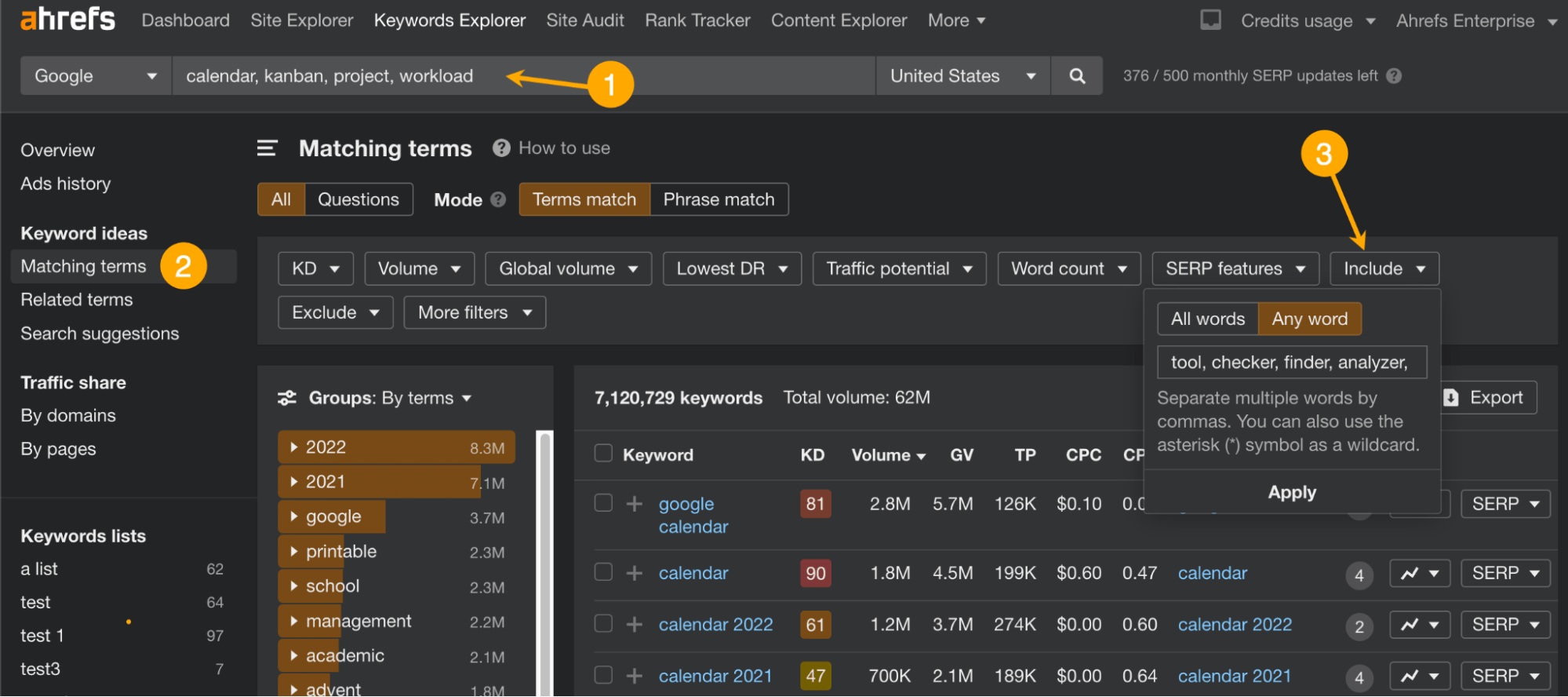
To illustrate, our free website traffic checker tool generates an estimated 33.4K organic visits each month from ranking for keywords like “website traffic checker” or even “website traffic.”


Content marketing is the process of creating and distributing content to attract and retain customers.
If you add search engine optimization to the equation, you get a framework for creating content relevant to your business and the reader. You also get a built-in distribution engine that generates almost free traffic.
SEO is one of the most sustainable marketing strategies because it generates passive traffic that accumulates over time and can generate traffic even years after. To put it differently, SEO results are continuous—and you don’t get that with all marketing strategies.
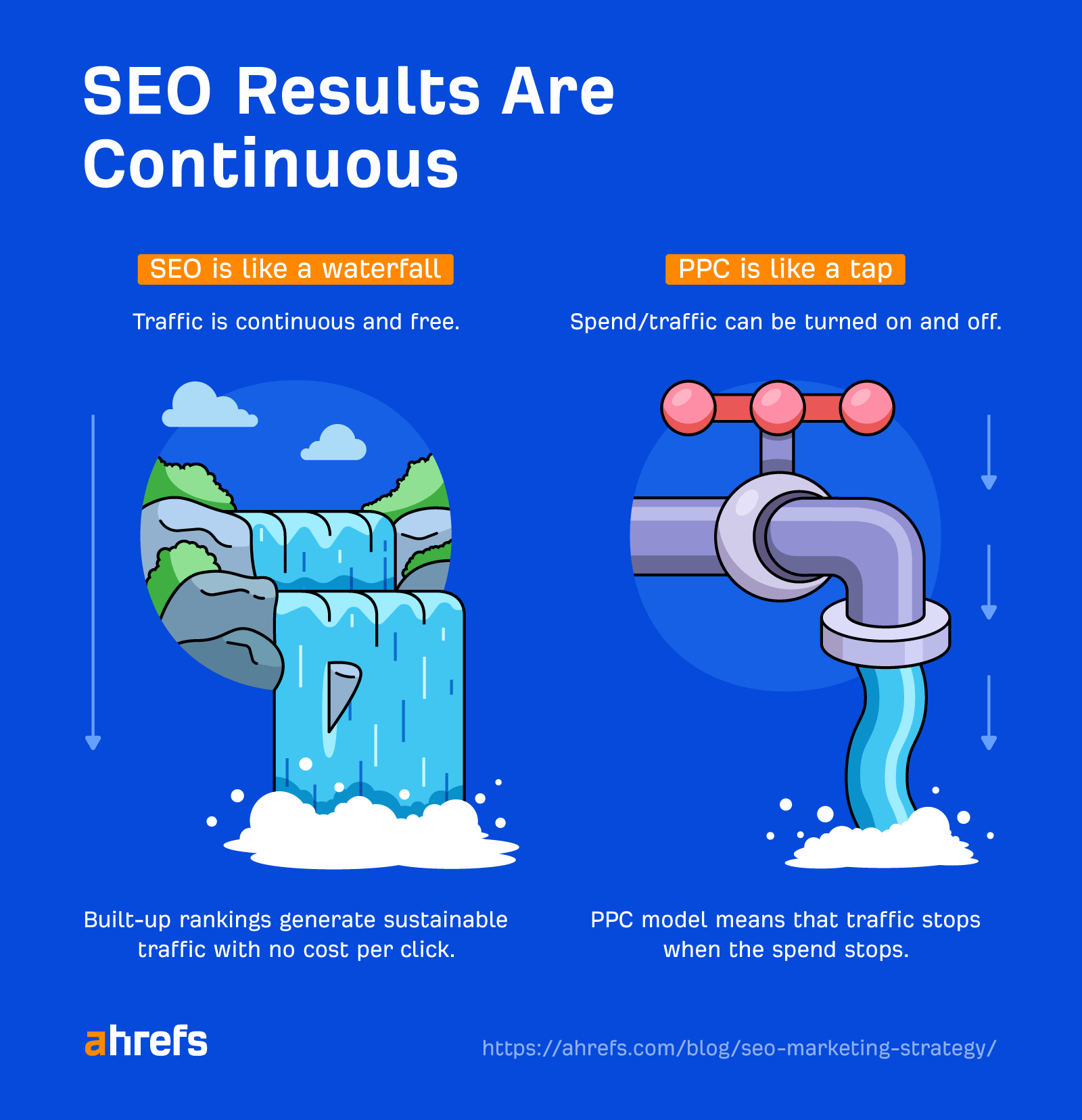
Our blog is an example of such a strategy. It brings an estimated 628K organic visits each month, worth around $860K in ad money, through regular publishing of SEO content.

How it works
SEO is generally worth it if at least one of these is true:
- People are searching for what you sell or do.
- People are searching for solutions to problems your business helps to solve.
- You can give a better solution than the conventional one people are searching for.
In any case, the core of this strategy is to find relevant keywords with traffic potential. The right keywords can connect you with your target audience and create an opportunity to pitch your product. And if you’re not ranking for these keywords, your competitors will.
The process of finding the right keywords for your website is called keyword research. Here’s a quick rundown:
- Go to Keywords Explorer
- Enter industry-related seed keywords, e.g., “seo, digital marketing, keyword, backlink”
- See keyword ideas in the Matching terms report
- Use the filters to refine results if needed (e.g., look only for low-competition keywords or keywords with a certain minimum traffic potential)

Other elements of the SEO process are building a sound technical foundation, creating optimized content, and building links. You can learn how to start with the entire process in our beginner’s guide to SEO.
A user community can help your SaaS product in a number of ways:
- It helps to make the product better through feedback.
- It helps to spread word of mouth about the product even if the community is exclusive.
- It offers added value to the user—they can learn from others in the community and network.
Building a user community is a sustainable strategy because it leverages existing customers and can help facilitate long-term engagement with the product.
A famous example of a community with a price tag on it is Behance, acquired by Adobe for $150M. It generates over 10M search visits each month and allows the parent company to bring the design community very close to its product.
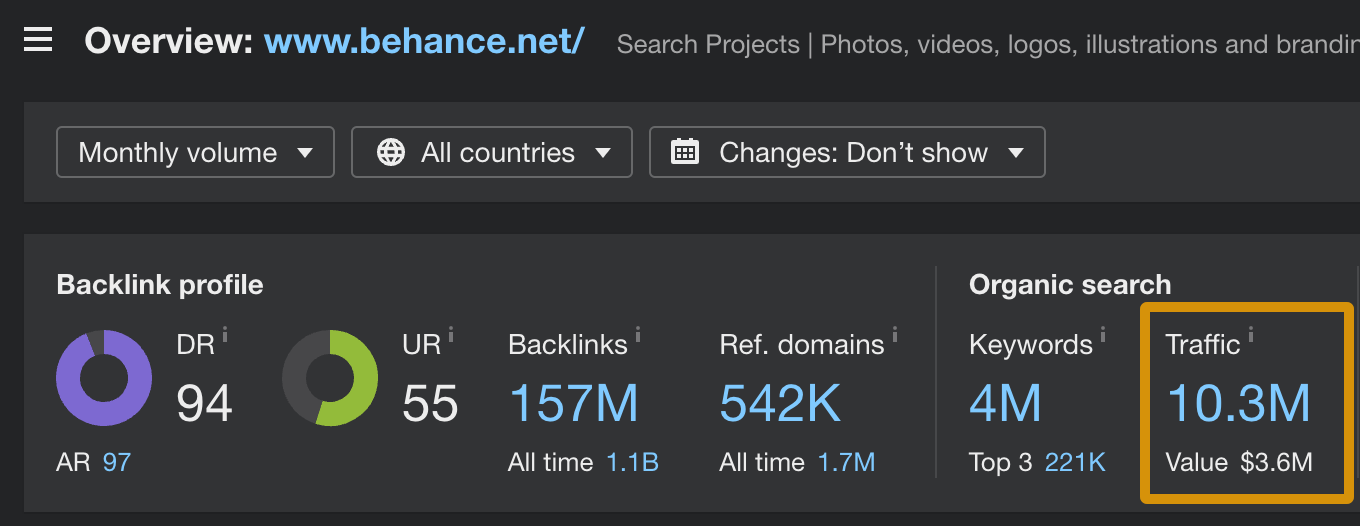

How it works
In a nutshell: create a place where people can meet online, build a constant presence there, and animate the community (feature launches, discussions, polls, etc.).
For example, at Ahrefs, we offer access to our exclusive community, Ahrefs Insider, with every subscription. All we needed to start it was a regular community feature on Facebook. Now it gathers a total of 17K registered users.

Earned media is publicity gained organically from promotional efforts, like press coverage, social media mentions, and search engine rankings.
Earned media is a sustainable form of marketing for these reasons:
- It’s cheaper in the long run compared to advertising (sometimes even free).
- It’s long lasting.
- It earns your brand awareness and credibility.
Here’s an example that checks all three boxes. A while ago, we published a data study showing that 90.63% of content gets no traffic from Google. This article was mentioned by multiple reputable websites, including NY Times, Forbes, and main SEO blogs. All of that coverage gave us free brand exposure and backlinks.

How it works
Earned traffic covers a wide range of marketing tactics, so there’s no silver bullet here. Besides SEO content, which we already touched on, the tactics that are repeatable and will probably have the most impact over time are:
When vetting which site to pitch your product, story, or quote to, you can use Ahrefs’ SEO Toolbar. For instance, say you’re looking for websites that review SaaS products like yours. Just search for your competitors’ reviews in Google and look at the metrics to see which sites can send you stronger links and considerable traffic.

Multi-channel marketing is basically about interacting with your audience using different marketing channels: social media, search, podcasts, email, etc.
Using multi-channel marketing will have the following advantages:
- A broader reach.
- Channels can work to support each other. For example, social media can help you to get links to websites and boost your SEO.
- You create convenience for your audience to interact with the brand.
- There’s less risk, thanks to diversification.
The idea behind this strategy is that your audience is likely scattered across various websites and social media platforms. So even if one marketing channel works exceptionally well, you probably shouldn’t drop all other channels.
How it works
Here are some ideas on how to find the best marketing channels for your business:
- You can see where your competitors promote.
- Do keyword research to estimate organic traffic for relevant keywords (we discussed it in point #3).
- Use audience research tools like SparkToro. Below, you can see a screenshot showing what kind of data about your audience the tool can provide.
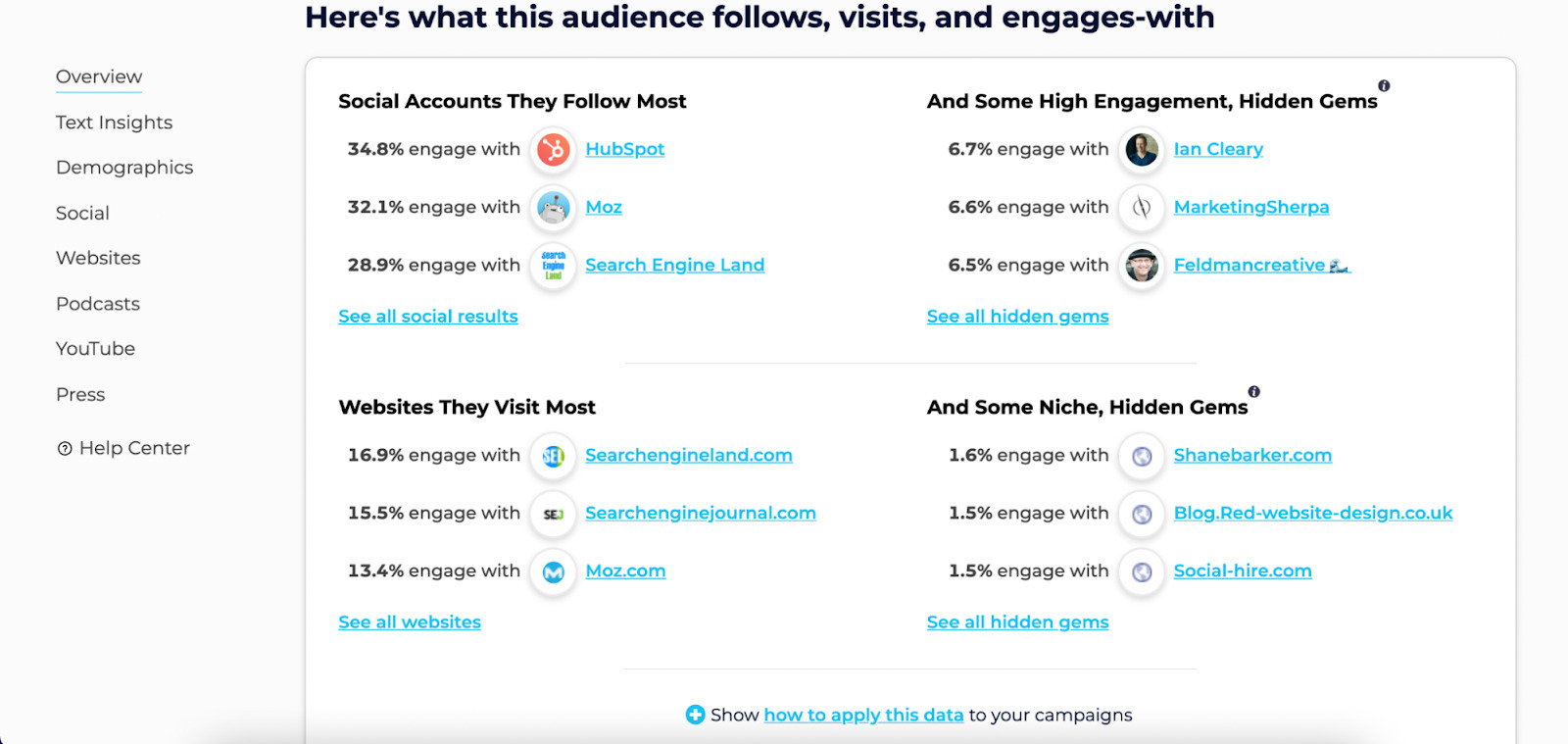
Furthermore, using multiple marketing channels allows you to distribute content more effectively. You can:
- Repurpose content into other formats and platforms.
- Build an audience to distribute content directly (for example, grow your email list).
- Promote the content via ads or sponsored newsletters.
- Syndicate articles to other websites.
Here’s an example. Our thoughts on using ChatGPT for SEO were used in a YouTube video, on our blog, and on social media. While there may be some overlap between these audiences, they are definitely not identical. So by using the multi-channel approach, we were able to get more eyes on our content.
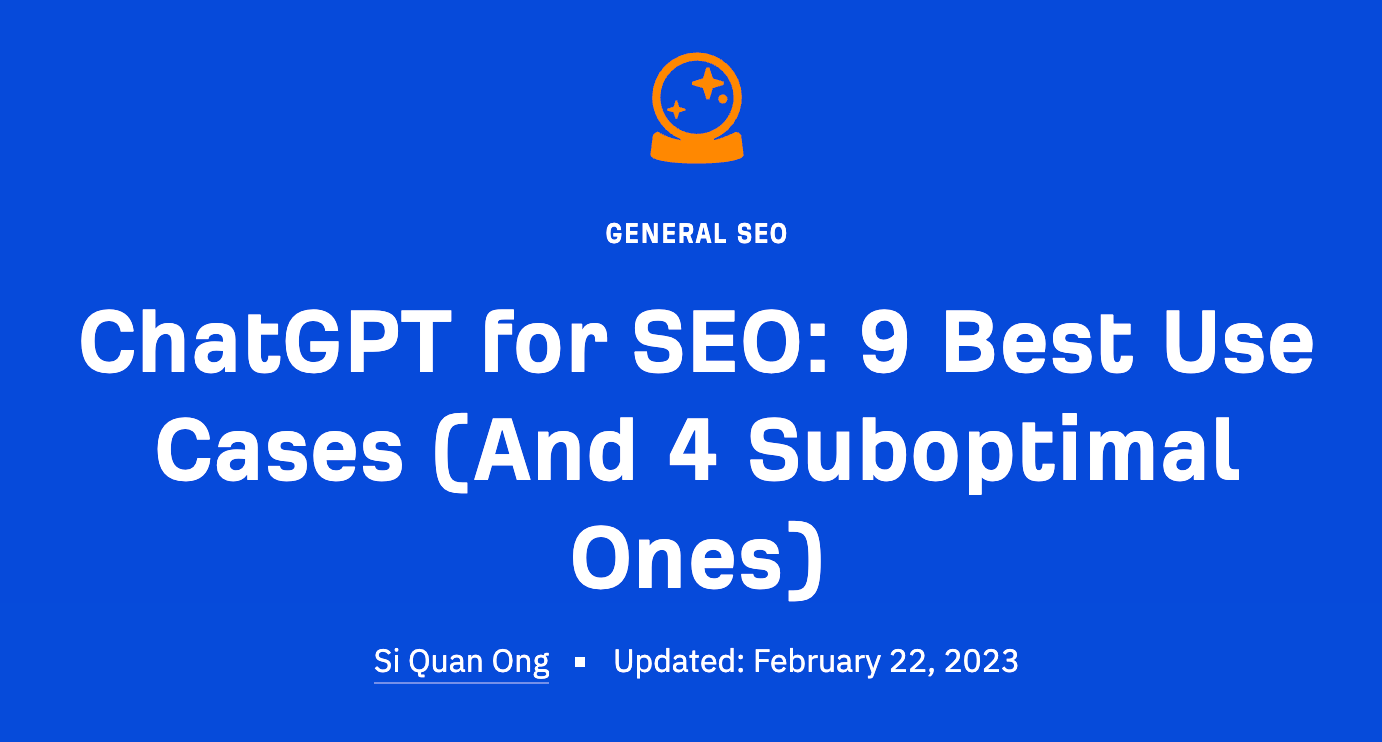
A growth loop is a system where new user input creates an output that drives product demand.
To illustrate, here’s how Notion used a product feature to activate and retain users (courtesy of Foundation).
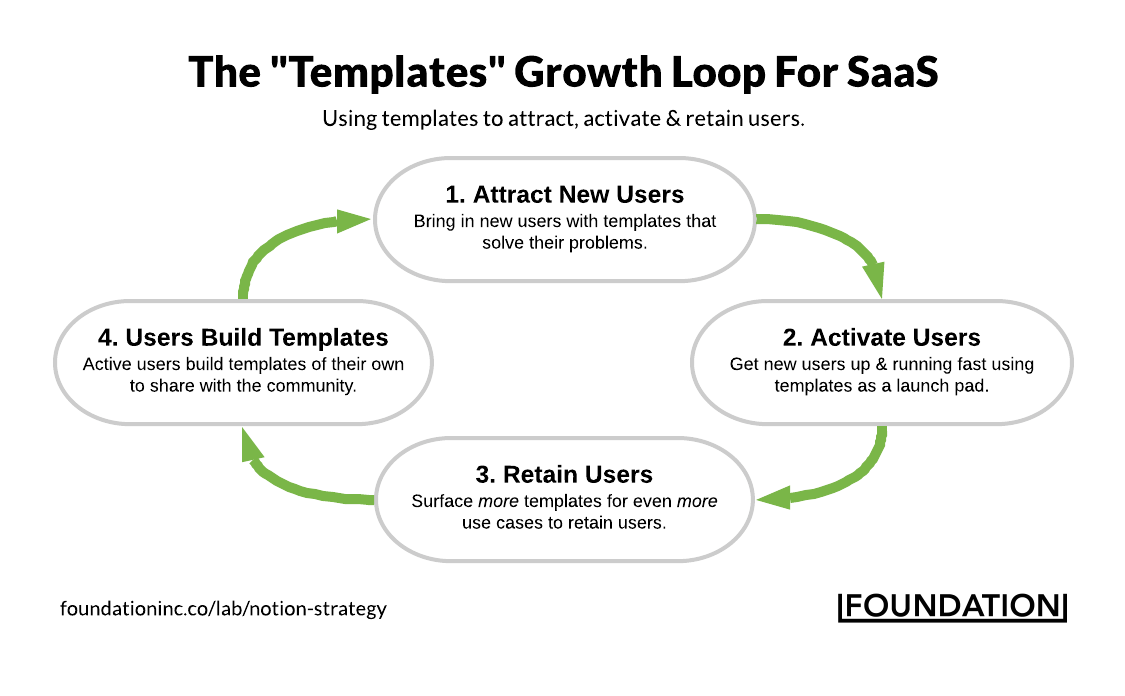
Growth loops are a stellar example of a sustainable marketing strategy because the whole model creates a loop. The more you grow, the more users you get, and so the more you grow.
Furthermore, this strategy gives your marketing budget more “power” since each dollar invested in acquiring a user is also invested in the users generated via the loop.
How it works
The simplest (but super effective) form of a growth loop is making your product outstanding. When your customers love the product and recommend it to others, you start growing on word of mouth—you acquire users you spent nothing to get.
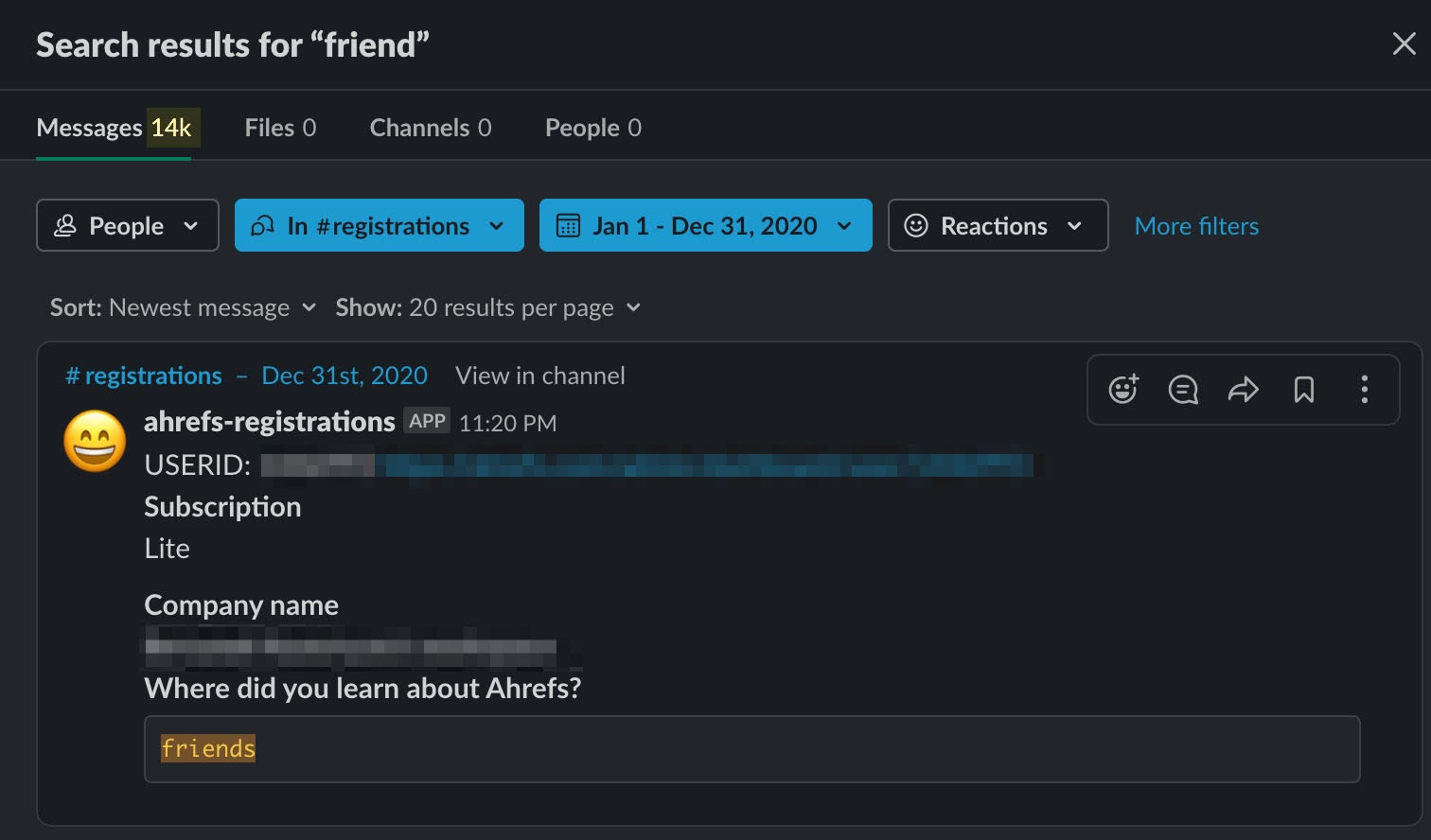
In some types of products, it’s possible to go beyond word of mouth and create a typical growth loop. It all depends on your product and your creativity. Here are a couple of levers you can pull:
- Make it easier for users to share their work publicly like Adobe with Behance
- Devise a referral program like Dropbox
- Create a marketplace for apps like Atlassian or WordPress
- Release an API like OpenAI
- Encourage user-generated content like G2
- Allow for free product usage after creating a free account like Figma or Loom
- Allow users to invite others to their workspaces like Slack or Miro
Revenue expansion is the additional revenue you get from your existing customers through upselling, cross-selling, and add-ons.
It’s a strategy that has proven to work for decades in multiple industries. For instance, this is why when you order a regular pizza, you’re offered to get a bigger one, get a drink with it, or add some extra ingredients.
And here’s an example from the SaaS world. When subscribing to HubSpot, you’re offered to upgrade by increasing the limit of contacts and also to purchase add-ons.
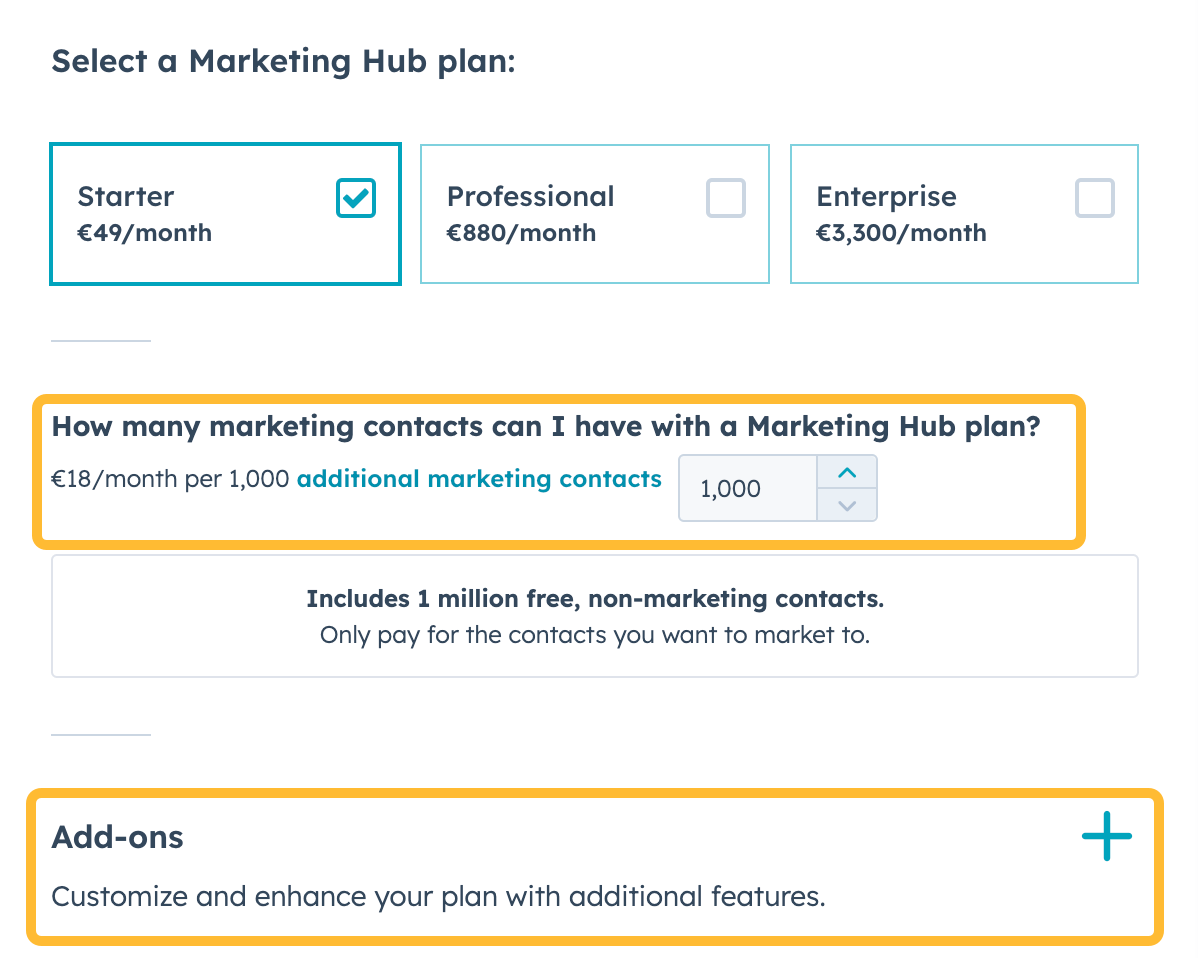
According to a correlation study published by ProfitWell, SaaS subscription-based companies should aim for 20% to 30% expansion revenue in their overall revenue in order to succeed.

You’ve probably heard that it’s better to retain a customer than to get a new one. That old business adage still holds true. According to this 2016 survey, SaaS companies spend an average of $1.16 to earn $1 on new annual contract value but only $0.27 on upsells and $0.20 on plan expansions.
How it works
If you offer additional value to your satisfied customers, there’s a good chance those customers will be happy to buy more from you. Here are some ideas for creating value for revenue expansion:
- Offer premium features on higher plans
- Offer a per-seat model to cater to both small and large companies
- Add a custom/enterprise tier for the most demanding customers
- Offer priority support
For example, when design tool UXPin developed a way to design with production-ready components, it decided to offer that as a premium version of the product with an almost 80% higher price tag than the UXPin Standard version.

But how to know when and if your customers are willing to expand? Here are some signals:
- Customers often reach their usage limit.
- Customers express interest in additional features or higher tiers.
- Your competitors offer a successful expansion system.
- You’ve got an awesome idea for a premium feature.
Growth marketing is the process of increasing a company’s revenue by applying an experiment-driven and integrated approach to all stages of attracting customers.
To understand this type of marketing better, let’s compare it to traditional marketing and growth hacking (the close variant I don’t recommend).

While the obvious solution for more sales is getting more visitors, this is not always the best one. If the product lacks competitive features and if there are obstacles on the path to purchase, money spent on getting more people through the door will always lead to low conversion and high churn. This is where growth marketing comes in.
A great example of growth-oriented thinking is LinkedIn’s Reconnect Flow. It’s a nickname for the early onboarding process where new users were asked questions about their personal experiences and offered connections to existing LinkedIn users based on that. This simple tactic engaged both new and old users.
Another interesting growth tactic LinkedIn used in the early days was encouraging users to import their email contacts (not a common thing back then). It was enough for 7% of new users to import their contacts to increase the overall number of invitations to 30%.
How it works
The idea behind growth marketing is based on the scientific method: propose hypotheses and validate them through experimentation. In marketing, it’s known as the growth hacking cycle.
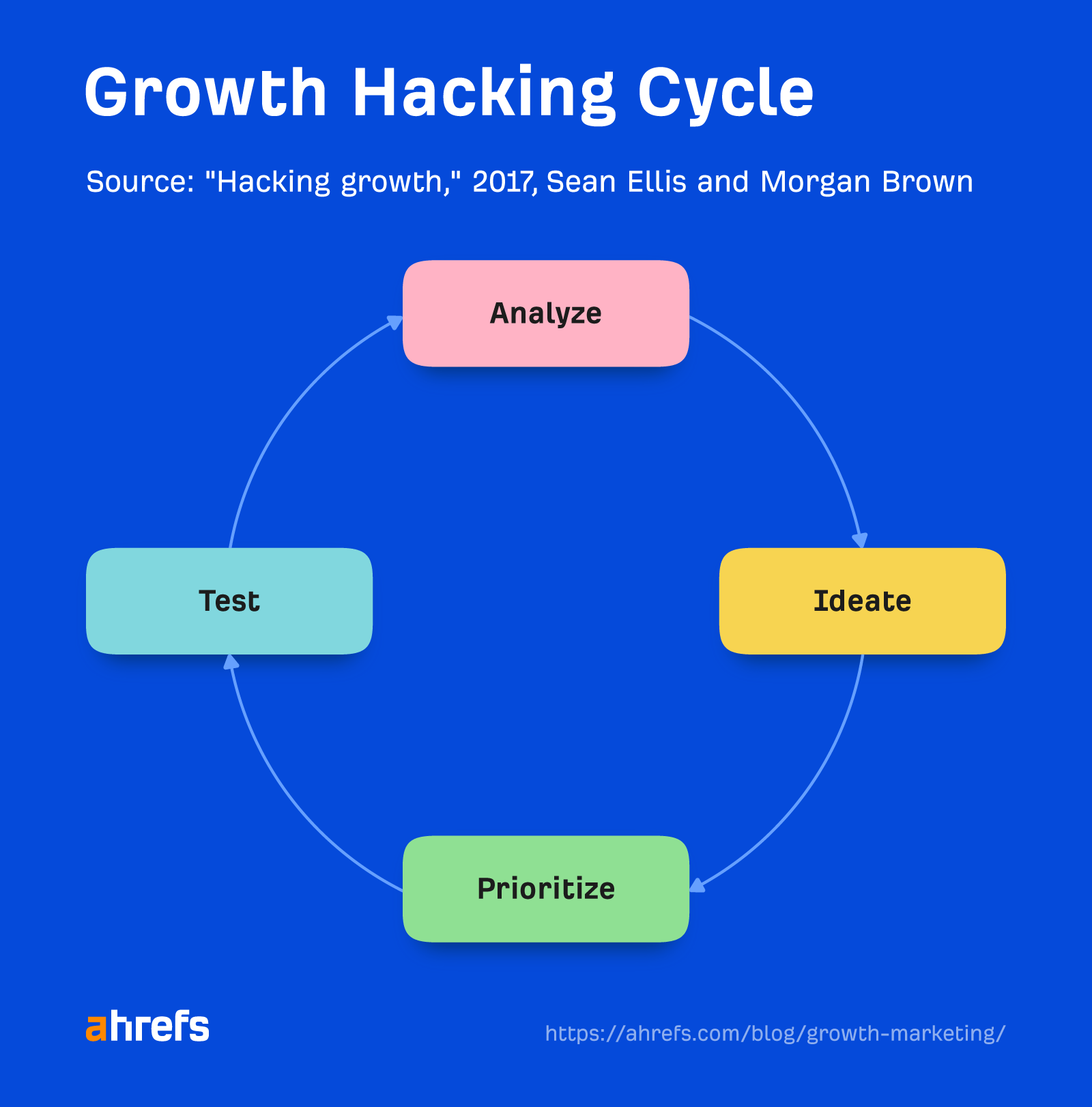
The whole cycle starts by gathering data on the buyer’s journey. Next is generating ideas on how to improve and then testing those ideas (for example through A/B testing).
It may seem like an obvious way to do marketing. But it’s not always that easy: Some tests may be hard to perform, and discipline is required. Also, it’s always faster (but not better) to go with your gut.
An important part of the growth mindset is the ability to analytically break down big problems into smaller pieces. This approach allows for setting more achievable goals.
For instance, a goal to increase sales is too vague because sales rely on many factors and not all of them are controllable. Instead, growth marketers may want to discover what “moves the needle.” Depending on the product, this may be encouraging the user to perform specific actions in the product or gearing pricing and communication toward a new audience.
Final thoughts
Sustainable growth doesn’t rely only on the strategies or tactics you choose. You need to give them time to work out the returns. You also need to experiment with them to see what works best for you.
There’s a great talk by Rand Fishkin on the concept of the flywheel in marketing; how the first push is the hardest, but it builds momentum that makes things easier in the long run. Sustainable growth strategies are just like that. As you build more value into your product and your brand, you gain momentum that acts as a multiplier for every new thing you do.
Got questions or comments? Ping me on Twitter or Mastodon.
SEO
An In-Depth Guide And Best Practices For Mobile SEO

Over the years, search engines have encouraged businesses to improve mobile experience on their websites. More than 60% of web traffic comes from mobile, and in some cases based on the industry, mobile traffic can reach up to 90%.
Since Google has completed its switch to mobile-first indexing, the question is no longer “if” your website should be optimized for mobile, but how well it is adapted to meet these criteria. A new challenge has emerged for SEO professionals with the introduction of Interaction to Next Paint (INP), which replaced First Input Delay (FID) starting March, 12 2024.
Thus, understanding mobile SEO’s latest advancements, especially with the shift to INP, is crucial. This guide offers practical steps to optimize your site effectively for today’s mobile-focused SEO requirements.
What Is Mobile SEO And Why Is It Important?
The goal of mobile SEO is to optimize your website to attain better visibility in search engine results specifically tailored for mobile devices.
This form of SEO not only aims to boost search engine rankings, but also prioritizes enhancing mobile user experience through both content and technology.
While, in many ways, mobile SEO and traditional SEO share similar practices, additional steps related to site rendering and content are required to meet the needs of mobile users and the speed requirements of mobile devices.
Does this need to be a priority for your website? How urgent is it?
Consider this: 58% of the world’s web traffic comes from mobile devices.
If you aren’t focused on mobile users, there is a good chance you’re missing out on a tremendous amount of traffic.
Mobile-First Indexing
Additionally, as of 2023, Google has switched its crawlers to a mobile-first indexing priority.
This means that the mobile experience of your site is critical to maintaining efficient indexing, which is the step before ranking algorithms come into play.
Read more: Where We Are Today With Google’s Mobile-First Index
How Much Of Your Traffic Is From Mobile?
How much traffic potential you have with mobile users can depend on various factors, including your industry (B2B sites might attract primarily desktop users, for example) and the search intent your content addresses (users might prefer desktop for larger purchases, for example).
Regardless of where your industry and the search intent of your users might be, the future will demand that you optimize your site experience for mobile devices.
How can you assess your current mix of mobile vs. desktop users?
An easy way to see what percentage of your users is on mobile is to go into Google Analytics 4.
- Click Reports in the left column.
- Click on the Insights icon on the right side of the screen.
- Scroll down to Suggested Questions and click on it.
- Click on Technology.
- Click on Top Device model by Users.
- Then click on Top Device category by Users under Related Results.
- The breakdown of Top Device category will match the date range selected at the top of GA4.
You can also set up a report in Looker Studio.
- Add your site to the Data source.
- Add Device category to the Dimension field.
- Add 30-day active users to the Metric field.
- Click on Chart to select the view that works best for you.
 Screenshot from Looker Studio, March 2024
Screenshot from Looker Studio, March 2024You can add more Dimensions to really dig into the data to see which pages attract which type of users, what the mobile-to-desktop mix is by country, which search engines send the most mobile users, and so much more.
Read more: Why Mobile And Desktop Rankings Are Different
How To Check If Your Site Is Mobile-Friendly
Now that you know how to build a report on mobile and desktop usage, you need to figure out if your site is optimized for mobile traffic.
While Google removed the mobile-friendly testing tool from Google Search Console in December 2023, there are still a number of useful tools for evaluating your site for mobile users.
Bing still has a mobile-friendly testing tool that will tell you the following:
- Viewport is configured correctly.
- Page content fits device width.
- Text on the page is readable.
- Links and tap targets are sufficiently large and touch-friendly.
- Any other issues detected.
Google’s Lighthouse Chrome extension provides you with an evaluation of your site’s performance across several factors, including load times, accessibility, and SEO.
To use, install the Lighthouse Chrome extension.
- Go to your website in your browser.
- Click on the orange lighthouse icon in your browser’s address bar.
- Click Generate Report.
- A new tab will open and display your scores once the evaluation is complete.
 Screenshot from Lighthouse, March 2024
Screenshot from Lighthouse, March 2024You can also use the Lighthouse report in Developer Tools in Chrome.
- Simply click on the three dots next to the address bar.
- Select “More Tools.”
- Select Developer Tools.
- Click on the Lighthouse tab.
- Choose “Mobile” and click the “Analyze page load” button.
 Screenshot from Lighthouse, March 2024
Screenshot from Lighthouse, March 2024Another option that Google offers is the PageSpeed Insights (PSI) tool. Simply add your URL into the field and click Analyze.
PSI will integrate any Core Web Vitals scores into the resulting view so you can see what your users are experiencing when they come to your site.
 Screenshot from PageSpeed Insights, March 2024
Screenshot from PageSpeed Insights, March 2024Other tools, like WebPageTest.org, will graphically display the processes and load times for everything it takes to display your webpages.
With this information, you can see which processes block the loading of your pages, which ones take the longest to load, and how this affects your overall page load times.
You can also emulate the mobile experience by using Developer Tools in Chrome, which allows you to switch back and forth between a desktop and mobile experience.
 Screenshot from Google Chrome Developer Tools, March 2024
Screenshot from Google Chrome Developer Tools, March 2024Lastly, use your own mobile device to load and navigate your website:
- Does it take forever to load?
- Are you able to navigate your site to find the most important information?
- Is it easy to add something to cart?
- Can you read the text?
Read more: Google PageSpeed Insights Reports: A Technical Guide
How To Optimize Your Site Mobile-First
With all these tools, keep an eye on the Performance and Accessibility scores, as these directly affect mobile users.
Expand each section within the PageSpeed Insights report to see what elements are affecting your score.
These sections can give your developers their marching orders for optimizing the mobile experience.
While mobile speeds for cellular networks have steadily improved around the world (the average speed in the U.S. has jumped to 27.06 Mbps from 11.14 Mbps in just eight years), speed and usability for mobile users are at a premium.
Read more: Top 7 SEO Benefits Of Responsive Web Design
Best Practices For Mobile Optimization
Unlike traditional SEO, which can focus heavily on ensuring that you are using the language of your users as it relates to the intersection of your products/services and their needs, optimizing for mobile SEO can seem very technical SEO-heavy.
While you still need to be focused on matching your content with the needs of the user, mobile search optimization will require the aid of your developers and designers to be fully effective.
Below are several key factors in mobile SEO to keep in mind as you’re optimizing your site.
Site Rendering
How your site responds to different devices is one of the most important elements in mobile SEO.
The two most common approaches to this are responsive design and dynamic serving.
Responsive design is the most common of the two options.
Using your site’s cascading style sheets (CSS) and flexible layouts, as well as responsive content delivery networks (CDN) and modern image file types, responsive design allows your site to adjust to a variety of screen sizes, orientations, and resolutions.
With the responsive design, elements on the page adjust in size and location based on the size of the screen.
You can simply resize the window of your desktop browser and see how this works.
 Screenshot from web.dev, March 2024
Screenshot from web.dev, March 2024This is the approach that Google recommends.
Adaptive design, also known as dynamic serving, consists of multiple fixed layouts that are dynamically served to the user based on their device.
Sites can have a separate layout for desktop, smartphone, and tablet users. Each design can be modified to remove functionality that may not make sense for certain device types.
This is a less efficient approach, but it does give sites more control over what each device sees.
While these will not be covered here, two other options:
- Progressive Web Apps (PWA), which can seamlessly integrate into a mobile app.
- Separate mobile site/URL (which is no longer recommended).
Read more: An Introduction To Rendering For SEO
Interaction to Next Paint (INP)
Google has introduced Interaction to Next Paint (INP) as a more comprehensive measure of user experience, succeeding First Input Delay. While FID measures the time from when a user first interacts with your page (e.g., clicking a link, tapping a button) to the time when the browser is actually able to begin processing event handlers in response to that interaction. INP, on the other hand, broadens the scope by measuring the responsiveness of a website throughout the entire lifespan of a page, not just first interaction.
Note that actions such as hovering and scrolling do not influence INP, however, keyboard-driven scrolling or navigational actions are considered keystrokes that may activate events measured by INP but not scrolling which is happeing due to interaction.
Scrolling may indirectly affect INP, for example in scenarios where users scroll through content, and additional content is lazy-loaded from the API. While the act of scrolling itself isn’t included in the INP calculation, the processing, necessary for loading additional content, can create contention on the main thread, thereby increasing interaction latency and adversely affecting the INP score.
What qualifies as an optimal INP score?
- An INP under 200ms indicates good responsiveness.
- Between 200ms and 500ms needs improvement.
- Over 500ms means page has poor responsiveness.
and these are common issues causing poor INP scores:
- Long JavaScript Tasks: Heavy JavaScript execution can block the main thread, delaying the browser’s ability to respond to user interactions. Thus break long JS tasks into smaller chunks by using scheduler API.
- Large DOM (HTML) Size: A large DOM ( starting from 1500 elements) can severely impact a website’s interactive performance. Every additional DOM element increases the work required to render pages and respond to user interactions.
- Inefficient Event Callbacks: Event handlers that execute lengthy or complex operations can significantly affect INP scores. Poorly optimized callbacks attached to user interactions, like clicks, keypress or taps, can block the main thread, delaying the browser’s ability to render visual feedback promptly. For example when handlers perform heavy computations or initiate synchronous network requests such on clicks.
and you can troubleshoot INP issues using free and paid tools.
As a good starting point I would recommend to check your INP scores by geos via treo.sh which will give you a great high level insights where you struggle with most.
 INP scores by Geos
INP scores by GeosRead more: How To Improve Interaction To Next Paint (INP)
Image Optimization
Images add a lot of value to the content on your site and can greatly affect the user experience.
From page speeds to image quality, you could adversely affect the user experience if you haven’t optimized your images.
This is especially true for the mobile experience. Images need to adjust to smaller screens, varying resolutions, and screen orientation.
- Use responsive images
- Implement lazy loading
- Compress your images (use WebP)
- Add your images into sitemap
Optimizing images is an entire science, and I advise you to read our comprehensive guide on image SEO how to implement the mentioned recommendations.
Avoid Intrusive Interstitials
Google rarely uses concrete language to state that something is a ranking factor or will result in a penalty, so you know it means business about intrusive interstitials in the mobile experience.
Intrusive interstitials are basically pop-ups on a page that prevent the user from seeing content on the page.
John Mueller, Google’s Senior Search Analyst, stated that they are specifically interested in the first interaction a user has after clicking on a search result.

Not all pop-ups are considered bad. Interstitial types that are considered “intrusive” by Google include:
- Pop-ups that cover most or all of the page content.
- Non-responsive interstitials or pop-ups that are impossible for mobile users to close.
- Pop-ups that are not triggered by a user action, such as a scroll or a click.
Read more: 7 Tips To Keep Pop-Ups From Harming Your SEO
Structured Data
Most of the tips provided in this guide so far are focused on usability and speed and have an additive effect, but there are changes that can directly influence how your site appears in mobile search results.
Search engine results pages (SERPs) haven’t been the “10 blue links” in a very long time.
They now reflect the diversity of search intent, showing a variety of different sections to meet the needs of users. Local Pack, shopping listing ads, video content, and more dominate the mobile search experience.
As a result, it’s more important than ever to provide structured data markup to the search engines, so they can display rich results for users.
In this example, you can see that both Zojirushi and Amazon have included structured data for their rice cookers, and Google is displaying rich results for both.
 Screenshot from search for [Japanese rice cookers], Google, March 2024
Screenshot from search for [Japanese rice cookers], Google, March 2024Adding structured data markup to your site can influence how well your site shows up for local searches and product-related searches.
Using JSON-LD, you can mark up the business, product, and services data on your pages in Schema markup.
If you use WordPress as the content management system for your site, there are several plugins available that will automatically mark up your content with structured data.
Read more: What Structured Data To Use And Where To Use It?
Content Style
When you think about your mobile users and the screens on their devices, this can greatly influence how you write your content.
Rather than long, detailed paragraphs, mobile users prefer concise writing styles for mobile reading.
Each key point in your content should be a single line of text that easily fits on a mobile screen.
Your font sizes should adjust to the screen’s resolution to avoid eye strain for your users.
If possible, allow for a dark or dim mode for your site to further reduce eye strain.
Headers should be concise and address the searcher’s intent. Rather than lengthy section headers, keep it simple.
Finally, make sure that your text renders in a font size that’s readable.
Read more: 10 Tips For Creating Mobile-Friendly Content
Tap Targets
As important as text size, the tap targets on your pages should be sized and laid out appropriately.
Tap targets include navigation elements, links, form fields, and buttons like “Add to Cart” buttons.
Targets smaller than 48 pixels by 48 pixels and targets that overlap or are overlapped by other page elements will be called out in the Lighthouse report.
Tap targets are essential to the mobile user experience, especially for ecommerce websites, so optimizing them is vital to the health of your online business.
Read more: Google’s Lighthouse SEO Audit Tool Now Measures Tap Target Spacing
Prioritizing These Tips
If you have delayed making your site mobile-friendly until now, this guide may feel overwhelming. As a result, you may not know what to prioritize first.
As with so many other optimizations in SEO, it’s important to understand which changes will have the greatest impact, and this is just as true for mobile SEO.
Think of SEO as a framework in which your site’s technical aspects are the foundation of your content. Without a solid foundation, even the best content may struggle to rank.
- Responsive or Dynamic Rendering: If your site requires the user to zoom and scroll right or left to read the content on your pages, no number of other optimizations can help you. This should be first on your list.
- Content Style: Rethink how your users will consume your content online. Avoid very long paragraphs. “Brevity is the soul of wit,” to quote Shakespeare.
- Image Optimization: Begin migrating your images to next-gen image formats and optimize your content display network for speed and responsiveness.
- Tap Targets: A site that prevents users from navigating or converting into sales won’t be in business long. Make navigation, links, and buttons usable for them.
- Structured Data: While this element ranks last in priority on this list, rich results can improve your chances of receiving traffic from a search engine, so add this to your to-do list once you’ve completed the other optimizations.
Summary
From How Search Works, “Google’s mission is to organize the world’s information and make it universally accessible and useful.”
If Google’s primary mission is focused on making all the world’s information accessible and useful, then you know they will prefer surfacing sites that align with that vision.
Since a growing percentage of users are on mobile devices, you may want to infer the word “everywhere” added to the end of the mission statement.
Are you missing out on traffic from mobile devices because of a poor mobile experience?
If you hope to remain relevant, make mobile SEO a priority now.
Featured Image: Paulo Bobita/Search Engine Journal
SEO
HARO Has Been Dead for a While

I know nothing about the new tool. I haven’t tried it. But after trying to use HARO recently, I can’t say I’m surprised or saddened by its death. It’s been a walking corpse for a while.
I used HARO way back in the day to build links. It worked. But a couple of months ago, I experienced the platform from the other side when I decided to try to source some “expert” insights for our posts.
After just a few minutes of work, I got hundreds of pitches:
So, I grabbed a cup of coffee and began to work through them. It didn’t take long before I lost the will to live. Every other pitch seemed like nothing more than lazy AI-generated nonsense from someone who definitely wasn’t an expert.
Here’s one of them:


Seriously. Who writes like that? I’m a self-confessed dullard (any fellow Dull Men’s Club members here?), and even I’m not that dull…
I don’t think I looked through more than 30-40 of the responses. I just couldn’t bring myself to do it. It felt like having a conversation with ChatGPT… and not a very good one!
Despite only reviewing a few dozen of the many pitches I received, one stood out to me:


Believe it or not, this response came from a past client of mine who runs an SEO agency in the UK. Given how knowledgeable and experienced he is (he actually taught me a lot about SEO back in the day when I used to hassle him with questions on Skype), this pitch rang alarm bells for two reasons:
- I truly doubt he spends his time replying to HARO queries
- I know for a fact he’s no fan of Neil Patel (sorry, Neil, but I’m sure you’re aware of your reputation at this point!)
So… I decided to confront him 😉
Here’s what he said:


Shocker.
I pressed him for more details:
I’m getting a really good deal and paying per link rather than the typical £xxxx per month for X number of pitches. […] The responses as you’ve seen are not ideal but that’s a risk I’m prepared to take as realistically I dont have the time to do it myself. He’s not native english, but I have had to have a word with him a few times about clearly using AI. On the low cost ones I don’t care but on authority sites it needs to be more refined.
I think this pretty much sums up the state of HARO before its death. Most “pitches” were just AI answers from SEOs trying to build links for their clients.
Don’t get me wrong. I’m not throwing shade here. I know that good links are hard to come by, so you have to do what works. And the reality is that HARO did work. Just look at the example below. You can tell from the anchor and surrounding text in Ahrefs that these links were almost certainly built with HARO:


But this was the problem. HARO worked so well back in the day that it was only a matter of time before spammers and the #scale crew ruined it for everyone. That’s what happened, and now HARO is no more. So…
If you’re a link builder, I think it’s time to admit that HARO link building is dead and move on.
No tactic works well forever. It’s the law of sh**ty clickthroughs. This is why you don’t see SEOs having huge success with tactics like broken link building anymore. They’ve moved on to more innovative tactics or, dare I say it, are just buying links.
Sidenote.
Talking of buying links, here’s something to ponder: if Connectively charges for pitches, are links built through those pitches technically paid? If so, do they violate Google’s spam policies? It’s a murky old world this SEO lark, eh?
If you’re a journalist, Connectively might be worth a shot. But with experts being charged for pitches, you probably won’t get as many responses. That might be a good thing. You might get less spam. Or you might just get spammed by SEOs with deep pockets. The jury’s out for now.
My advice? Look for alternative methods like finding and reaching out to experts directly. You can easily use tools like Content Explorer to find folks who’ve written lots of content about the topic and are likely to be experts.
For example, if you look for content with “backlinks” in the title and go to the Authors tab, you might see a familiar name. 😉


I don’t know if I’d call myself an expert, but I’d be happy to give you a quote if you reached out on social media or emailed me (here’s how to find my email address).
Alternatively, you can bait your audience into giving you their insights on social media. I did this recently with a poll on X and included many of the responses in my guide to toxic backlinks.


Either of these options is quicker than using HARO because you don’t have to sift through hundreds of responses looking for a needle in a haystack. If you disagree with me and still love HARO, feel free to tell me why on X 😉
SEO
Google Clarifies Vacation Rental Structured Data

Google’s structured data documentation for vacation rentals was recently updated to require more specific data in a change that is more of a clarification than it is a change in requirements. This change was made without any formal announcement or notation in the developer pages changelog.
Vacation Rentals Structured Data
These specific structured data types makes vacation rental information eligible for rich results that are specific to these kinds of rentals. However it’s not available to all websites. Vacation rental owners are required to be connected to a Google Technical Account Manager and have access to the Google Hotel Center platform.
VacationRental Structured Data Type Definitions
The primary changes were made to the structured data property type definitions where Google defines what the required and recommended property types are.
The changes to the documentation is in the section governing the Recommended properties and represents a clarification of the recommendations rather than a change in what Google requires.
The primary changes were made to the structured data type definitions where Google defines what the required and recommended property types are.
The changes to the documentation is in the section governing the Recommended properties and represents a clarification of the recommendations rather than a change in what Google requires.
Address Schema.org property
This is a subtle change but it’s important because it now represents a recommendation that requires more precise data.
This is what was recommended before:
“streetAddress”: “1600 Amphitheatre Pkwy.”
This is what it now recommends:
“streetAddress”: “1600 Amphitheatre Pkwy, Unit 6E”
Address Property Change Description
The most substantial change is to the description of what the “address” property is, becoming more descriptive and precise about what is recommended.
The description before the change:
PostalAddress
Information about the street address of the listing. Include all properties that apply to your country.
The description after the change:
PostalAddress
The full, physical location of the vacation rental.
Provide the street address, city, state or region, and postal code for the vacation rental. If applicable, provide the unit or apartment number.
Note that P.O. boxes or other mailing-only addresses are not considered full, physical addresses.
This is repeated in the section for address.streetAddress property
This is what it recommended before:
address.streetAddress Text
The full street address of your vacation listing.
And this is what it recommends now:
address.streetAddress Text
The full street address of your vacation listing, including the unit or apartment number if applicable.
Clarification And Not A Change
Although these updates don’t represent a change in Google’s guidance they are nonetheless important because they offer clearer guidance with less ambiguity as to what is recommended.
Read the updated structured data guidance:
Vacation rental (VacationRental) structured data
Featured Image by Shutterstock/New Africa
-

 WORDPRESS7 days ago
WORDPRESS7 days agoTurkish startup ikas attracts $20M for its e-commerce platform designed for small businesses
-

 PPC7 days ago
PPC7 days agoA History of Google AdWords and Google Ads: Revolutionizing Digital Advertising & Marketing Since 2000
-

 MARKETING6 days ago
MARKETING6 days agoRoundel Media Studio: What to Expect From Target’s New Self-Service Platform
-
SEARCHENGINES6 days ago
Daily Search Forum Recap: April 12, 2024
-

 SEO5 days ago
SEO5 days agoGoogle Limits News Links In California Over Proposed ‘Link Tax’ Law
-

 SEARCHENGINES7 days ago
SEARCHENGINES7 days agoGoogle Search Results Can Be Harmful & Dangerous In Some Cases
-

 MARKETING7 days ago
MARKETING7 days agoUnlocking the Power of AI Transcription for Enhanced Content Marketing Strategies
-

 SEO4 days ago
SEO4 days ago10 Paid Search & PPC Planning Best Practices














